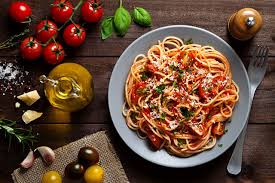Why do British People Love Italian Food So Much?
- Sofia Dagorret
- Mar 5, 2020
- 3 min read
As a British native, trying to explain our cuisine to people around the world is, frankly, impossible. We like Indian curries, Japanese sushi, Spanish paella, Mexican tacos, even more obscure countries like Hungary have snuck into the realm of “British cuisine” with Hungarian Goulash (which is definitely worth a try). But above all, we Brits are absolutely, undeniably, unequivocally in love with Italian food. But with such a wide variety of international gastronomic delights to choose from, it begs the question, just what keeps us coming back to Italian food?
We wouldn’t be able to appreciate dishes like the iconic Spaghetti Bolognese without the infinite availability of unexplainably cheap pasta on our supermarket shelves. It goes without saying that pasta is almost oxygen for the British populus at this point, especially the student population. Bashing together a spag bol to line the stomach before a sesh after a “long” day of “studying” is perhaps the most student thing there is, the reason being, it is just so accessible. With 500g of spaghetti costing around 60p and 400g of mince weighing in at about £3, a kilo of spag bol, or 4 servings, costs under £4. I can’t tell if it’s my palette or my wallet that’s enjoying writing this the most.
Having said that, unlike alcohol, it’s not like we just become pasta addicts on the first day of Freshers. The life-long adoration of those little Italian nuggets of joy starts as soon as we leave the womb, with the children’s food manufacturer, Ella’s Kitchen, offering a “spag bol with cheese” meal for kids at the age of just 7 months. I was fortunate enough that my mum would regularly dish up the best lasagna to ever come out of an oven on this planet so maybe I am a tad biased, but I’m sure there is no family within our borders that does not regularly indulge in the cuisine of our Vespa driving, suit designer friends. But there is surely a reason why so many parents decide the best course of action come dinner time is to turn to the country that bought us underfloor heating for inspiration. Well, perhaps it is far more ingrained in us than you might think.
As with all addendums to the ever-growing British culture, the advent of Italian cuisine came through immigration. It might be a bit extreme to call the Roman invasion of Britain a phase of immigration, but nonetheless, this is where our love affair started. After planting the seed by introducing us to the likes of garlic, onions and asparagus in the early days of Roman Britain, the popularity of Italian food began to rise. By medieval times, pasta had become a favourite of high society and, as such, synonymous with wealth and culture. Even England’s first cooking book, from 1390, contained recipes for losyns (lasagna), makerouns (macaroni) and rauioles (ravioli). Throughout the rest of our country’s history, Italians continued to cross the channel and contribute to our mealtime enjoyment, firmly cementing their country’s place at the top of Britain’s favourite cuisines.
Now, I must apologise for my somewhat fanatical approach to this article, however, it must be said that while some Brits are very keen to place immigration and multiculturalism in a negative light, but those same people will quite happily grab a pizza, kebab, curry or a Chinese on a cold, rainy, typically British evening. So, to those people I say, you can rave about the negative aspects of immigration as much as you wish, but there is no denying that, at least gastronomically, it is the best thing to ever happen to our country.
Brad Ewles







Comments